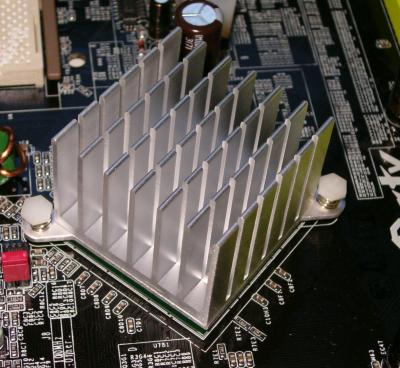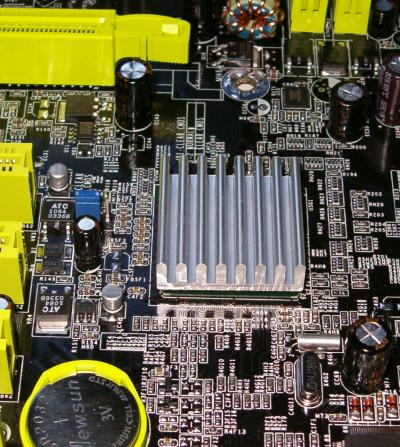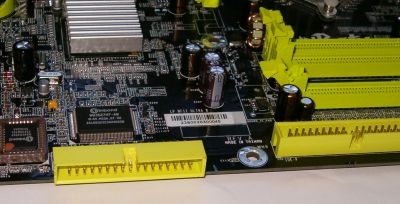Layout

Ignoring the CPU socket which had a run in with a paste covered CPU I foolishly tested in the DFI before photographing it, let's take a look at layout in the usual way.
I mentioned on the previous page that the B revision board has seen a slight layout change compared the older board, due to the removal of a couple of space claiming IDE ports and the required electrical traces. This manifests itself straight away with the movement of the CPU socket a little closer to the ATX I/O backplane than before. The socket continues to be orientated north-south and possesses heatsink mounting holes around it, something not present on the original. That's not to say the socket holes are entirely usable however. Due to the close proximity of some surface mount components to the top left hole, I was unable to fit either my Swiftech MCX462 heatsink, nor Asetek's latest CPU waterblock from their new WaterChill hardware. It rests right up against the hole's edge, making anything but a straight screw unable to be used. A shame.
The socket movement means that the 3-phase power hardware gets moved from the left of the socket edge, in between the socket and the I/O backplane on the old board, instead residing underneath the socket with an alternate component arrangement. The new arrangement shouldn't affect its operation, despite occupying a slightly smaller area on the board than before.
The socket movement also causes a knock-on effect in the positions of the ATX power cable header, the memory slots, the MCP-T provided IDE ports and the SPP bridge. All get shuffled around the board a little. The ATX power header moves from the top right edge of the board, to right next to a large capacitor near the right hand socket edge. While the old location was close to ideal for some cases, the new location still, helpfully, doesn't cause many cable routing issues that involve blocking the airflow from the CPU fan. The memory slots move nearer to the right edge of the board than before, while the pair of IDE ports get split up from their original grouping and sit along the right edge of the board in the space between DIMM3 and the board edge.

The SPP bridge moves ever so slightly to the right, still passively cooled by a large heatsink that dominates the features on the top half of the board. Passive cooling for the bridge means a thumbs up to DFI in their avoidance of a possibly whiny 40mm fan. The 4-pin auxiliary 12V ATX connector remains awkwardly alongside the top left corner of the AGP slot, the last major feature on the top half of the board. It would be nice if it was elsewhere, avoiding nuisance cable routing issues.

Moving on to the bottom half of the board below the AGP slot, we come across the same five PCI slots present on the old board. No sacrificing a PCI slot for features, unlike the Leadtek K7NCR18D Pro II Deluxe Limited. As mentioned before, sandwiched in between the first PCI slot and the AGP slot, sit the FireWire pin headers. In use, they didn't cause a problem, since there's generous space between AGP and PCI1, but beware if you use a graphics card that needs two backplane slots. It is a two-slot-cooler friendly board though, you don't lose a PCI slot with one on this board.
The southbridge has its hat on, hip hip hip hooray! Taking a cue from Leadtek, DFI give the MCP-T a natty heatsink for passive cooling. With chipset voltage adjustment and given that all 3 FireWire ports can be used, which are fed by the MCP-T, you can sort of see the need for its inclusion. But between you and me, it's almost all for show.
The battery holder swaps PCI slot sides, getting a minor relocation compared to the older board. Upside down Sil3114 feeds the adjacent quartet of ports, which themselves sit flush along the right hand edge, the very best place for them, given the maximum cable length provided by the SATA spec (1 metre).

The floppy port gets ABIT-like treatment, rotated to make the pins face out from the edge of the board. On the older board, the floppy port was located up where the secondary IDE port now sits on the new board. While the rotation is a good idea, giving you more scope for tidy cable routing, especially with the provided rounded floppy cable (more on that on the following page), I'm a bit perplexed as to why the IDE ports aren't given the same treatment. Boo hoo DFI, you'd have nearly the perfect layout otherwise.
Finally, the natty buttons for power and reset sit along the bottom edge of the PCB in the right hand corner, right next to the case headers. A boon for people like me that are constantly testing hardware, they're a cute inclusion, most welcome. Oh, and before I forget, a quartet of miniature LED's underneath the battery provide POST status, lighting up all red on successful boot. The headers next door to the actual LED's allow you to hookup your own quartet for display elsewhere (supplied with the FrontX).
All in all, a pretty accomplished layout, one I'm a fan of. Nothing much is in the wrong place, only the auxiliary power connector and reluctance of DFI to rotate the IDE headers are things I'd knock marks off for.
As for the looks, you'll either love them or hate them. Very dark brown PCB, UV reative green slots and red LED's aren't really my thing, but they might be yours. At least the board stands out against something from the likes of EPoX, which can only be a good thing. I prefer my board aesthetics a little more toned down. All black would be excellent, maybe something for an Anniversary edition?
Here's a shot of the ATX backplane I/O, showing off the paste attacked socket a little, before I talk about bundle.










